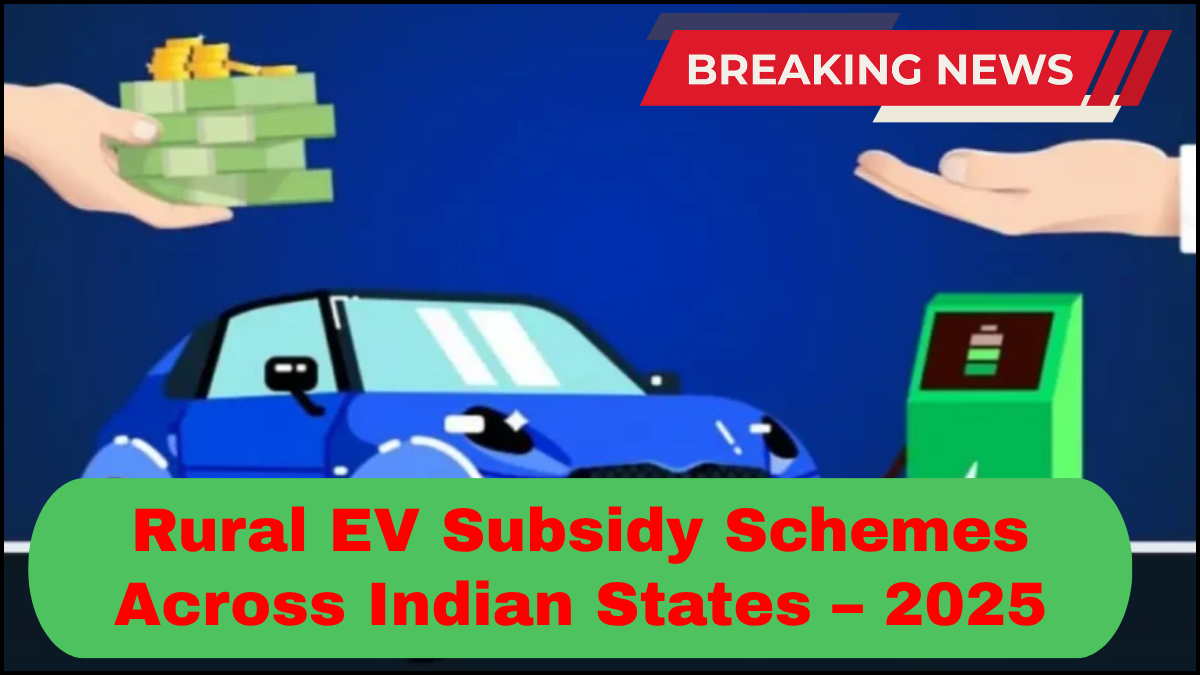India’s electric vehicle (EV) revolution is no longer confined to urban centers. In 2025, rural India is gaining ground in the transition toward sustainable mobility, thanks to targeted Rural EV subsidies in India. These government-backed incentives aim to make EVs more accessible to farmers, rural entrepreneurs, and small businesses across villages and remote areas.
Below is a comprehensive, state-wise guide to current rural EV subsidy schemes, reflecting the push towards a greener and more inclusive transportation future.

Why Rural EV Subsidies Matter
While urban EV adoption has grown steadily, rural regions often lag due to limited affordability, awareness, and infrastructure. Rural EV subsidies aim to bridge this gap by:
- Lowering upfront costs for electric two-wheelers, three-wheelers, and light commercial vehicles.
- Encouraging adoption among farmers, self-help groups, and delivery operators.
- Stimulating local employment through EV assembly, servicing, and charging stations.
- Reducing diesel and petrol dependence in agriculture and logistics.
State-Wise Guide to Rural EV Subsidy Schemes in 2025
1. Maharashtra
Maharashtra’s EV policy offers additional incentives for rural buyers beyond the central FAME-II scheme.
- Two-Wheelers: Up to Rs. 20,000 subsidy for rural youth and women-led SHGs.
- Three-Wheelers: Rs. 30,000 to Rs. 50,000 for cargo e-rickshaws used in agri-transport.
- Charging Infra: 25% capital subsidy on rural EV charging points.
2. Tamil Nadu
Tamil Nadu has integrated rural outreach into its EV ecosystem development:
- Direct Transfer: Farmers purchasing EV tractors and loaders get up to Rs. 75,000 credited directly.
- Local Assemblers: MSMEs in rural areas receive tax breaks for setting up EV units.
- Women Empowerment: Rural women purchasing e-scooters receive an additional 10% subsidy.
3. Uttar Pradesh
As part of its Rural Mobility Electrification Drive:
- Three-Wheelers: Subsidies up to Rs. 45,000 on electric rickshaws.
- Battery Swapping: Pilot stations introduced in tier-3 towns.
- Loan Support: Interest subvention for rural cooperatives buying EV fleets.
4. Gujarat
Known for its aggressive EV targets:
- Two-Wheelers: Rural students get up to Rs. 12,000 off on e-bikes.
- Fleet Conversion: Grants for converting diesel logistics vehicles to EVs.
- Skill Development: Training for EV servicing in village polytechnics.
5. Bihar
One of the new entrants in rural EV promotion:
- E-Rickshaws: Rs. 40,000 upfront subsidy plus Rs. 10,000 for battery replacement.
- Priority Financing: Tie-ups with Grameen banks for easy loans.
- Awareness Camps: Monthly outreach in blocks and Panchayats.
6. Karnataka
Focused on green energy integration:
- Solar-Powered EVs: 40% subsidy for solar-powered electric carts.
- Charging Infra: Grants to set up solar charging hubs in taluk centers.
- Transport for SHGs: Support for group EV purchases by self-help collectives.
Central Support: FAME-II Extension & PM-E-Vidya
The FAME-II scheme, extended into 2025, provides baseline subsidies on EVs. However, rural-specific schemes have emerged under PM-E-Vidya, a central initiative linking education, awareness, and rural mobility. Under this program:
- Rural students using EVs to attend higher education receive Rs. 15,000 subsidies.
- Digital learning vans powered by EVs get 50% capital assistance.
Challenges and the Road Ahead
Despite progress, challenges remain:
- Infrastructure Gaps: Charging stations are sparse beyond tier-2 cities.
- After-Sales Service: Rural areas lack skilled EV mechanics.
- Awareness: Many rural consumers still associate EVs with lower performance.
To address these, several states are integrating rural mobility with skill development, vocational training, and local manufacturing hubs.
Conclusion
The landscape for Rural EV subsidies in India is evolving fast. 2025 sees a significant shift as states actively build programs targeting villages and semi-urban communities. These efforts reflect a broader national vision: making electric mobility not just a city privilege, but a rural opportunity. If executed well, the combination of financial support, awareness, and infrastructure could transform India’s rural mobility in the next decade.
FAQs on Rural EV Subsidies in India (2025)
Q1. Who is eligible for rural EV subsidies?
Most schemes target rural residents, farmers, SHGs, and students. Specific eligibility varies by state.
Q2. Are these subsidies available on all types of EVs?
Generally, they apply to two-wheelers, three-wheelers (especially cargo and passenger), and light commercial vehicles. Some states also support electric tractors and carts.
Q3. Can I combine central FAME-II and state subsidies?
Yes. Most rural EV buyers can avail both, provided the vehicle model is approved under both schemes.
Q4. How can rural residents apply?
Applications are usually made through state transport departments, online EV portals, or in-person camps in rural blocks.
Q5. Are financing options also available?
Many states partner with rural banks and microfinance institutions to provide low-interest loans or EMI-based schemes.
click here to learn more